
There are a lot of different fishing techniques and one of the best for shallow waters is flipping and pitching. Flipping is not the same as pitching, but both are similar in their movement and use short casts. While most fishing poles are built to extend your casts, a rod for flipping and pitching is the opposite. So, it is important that you invest in a flipping and pitching rod to truly perfect this technique.
The best flipping rod will be no longer than 8 feet long and have a durable construction. A rod for flipping and pitching should also have a little more weight because that will give it the strength to combat fighting fish and maneuver around obstructions in the water. But if you’re new to flipping and pitching, you might feel a little lost when it comes to choosing a new rod.
With our list of the seven best flipping and pitching rods and detailed buying guide, we will help you find a quality rod that will help you perfect your technique and enhance your time spent fishing.
OUR TOP PICK
KastKing Carbon Fiber
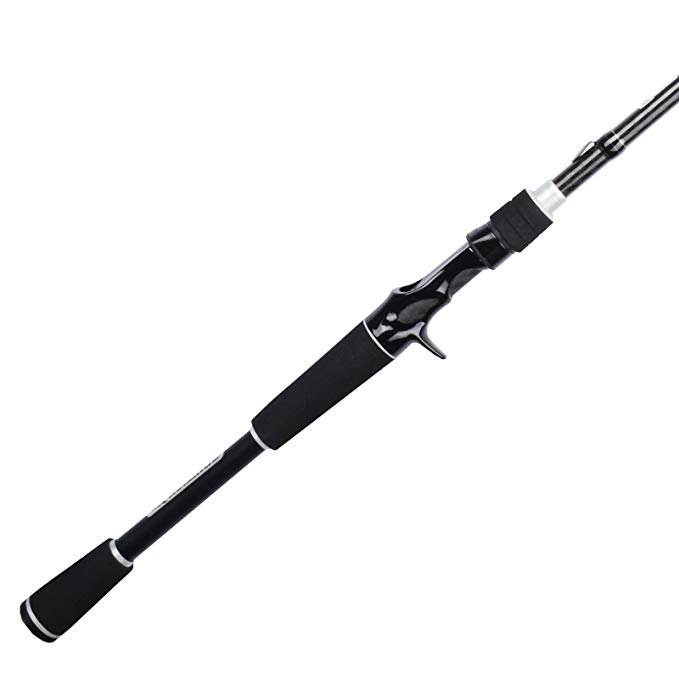
- Stand Out Features - Why We Love It
- Strong and durable with a carbon blank construction
- More accurate for casting and reeling
- Fuji O-ring guides are tangle and knot free
- Graphite reel seats and EVA grips for ergonomic comfort
- Even power throughout the rod
- Safe for fresh and saltwater
Weight: 3 pounds
Length: 7 feet 1 inch
Material: Carbon fiber
Action: Fast
Power: Medium
Pieces: 1
EDITORS CHOICE
Abu Garcia Vengeance Casting
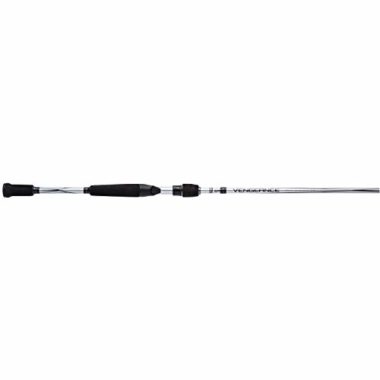
- Stand Out Features - Why We Love It
- Lightweight and balanced for perfect casts
- Graphite construction saves on weight but is extra strong
- Durable stainless-steel guides and titanium oxide inserts
- EVA high-density handle reduces fatigue and is more comfortable
- Medium heavy action is great for larger fish
Weight: 7.2 ounces
Length: 6 feet 9 inches
Material: Graphite
Action: Fast
Power: Medium heavy
Pieces: 1
BEST VALUE
Berkley Cherrywood HD
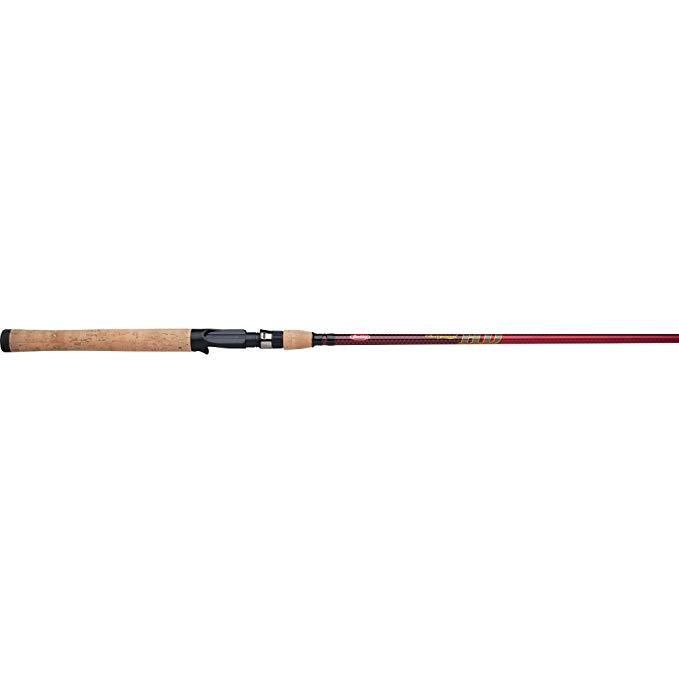
- Stand Out Features - Why We Love It
- Ultra-sensitive to feel all the fish’s movements on your hook and bait
- Sensitivity increases your chance of success
- Guides are 20 times tougher and 55% lighter
- Cork handle is well balanced and reliable
- Cherrywood body is attrative and long lasting
Weight: 6.4 ounces
Length: 7 feet
Material: Cherrywood
Action: Fast
Power: Medium heavy
Pieces: 1
KastKing Royale Legend
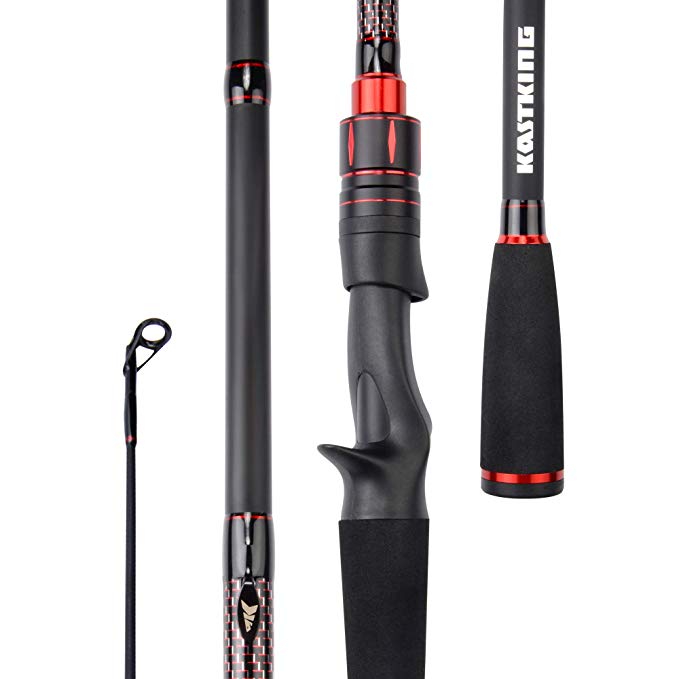
- Stand Out Features - Why We Love It
- Lightweight with a tournament performance
- Power to fish large species
- Sensitive with versatile Fuji O-ring guides
- Nylon reel seats are a strong base for casting
- Great for extreme fishing conditions
Weight: 2.4 pounds
Length: 7 feet 6 inches
Material: Carbon graphite
Action: Fast
Power: Extra heavy
Pieces: 1
KastKing Speed Demon Pro Series
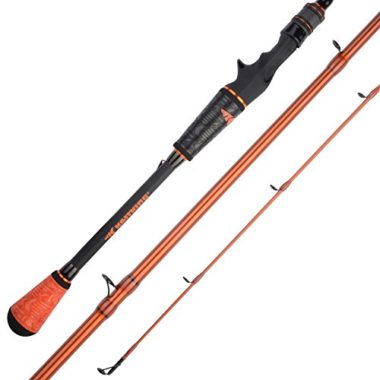
- Stand Out Features - Why We Love It
- Made with elite carbon blanks and nano resin technology
- 30% increased strength
- Fuji guide reduce friction to stop line fraying
- Golf style grip is more comfortable
- Large fighting butt for support
Weight: 3.6 pounds
Length: 7 feet 5 inches
Material: Carbon, nano resin
Action: Fast
Power: Heavy
Pieces: 1
KastKing Speed Demon Bass
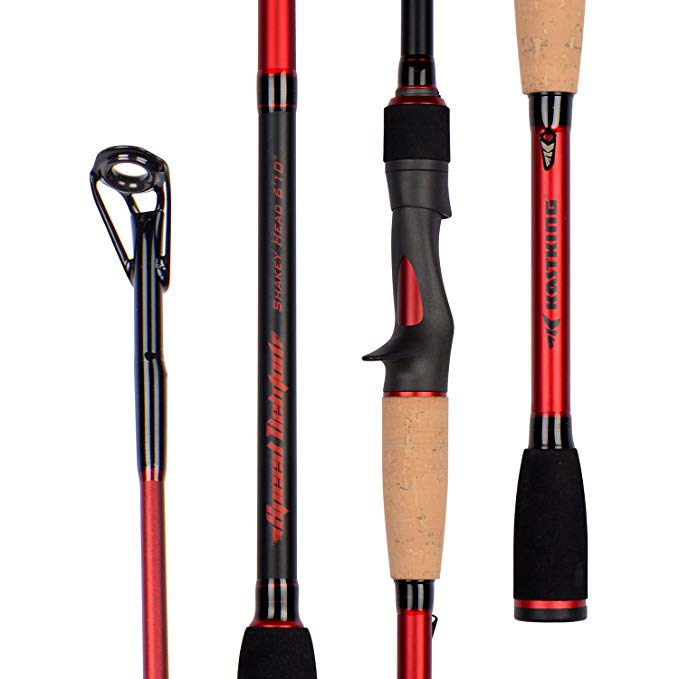
- Stand Out Features - Why We Love It
- Graphite blank technology has more power for fishing large bass
- More sensitivity to quickly set your hook
- Fuji guides and reel seats are more reliable
- Cork handle is solid and comfortable
- Versatile and can be used to catch trout or walleye
Weight: 3.5 pounds
Length: 7 feet 6 inches
Material: Graphite
Action: Fast
Power: Medium heavy
Pieces: 1
Okuma Scott Martin Tournament
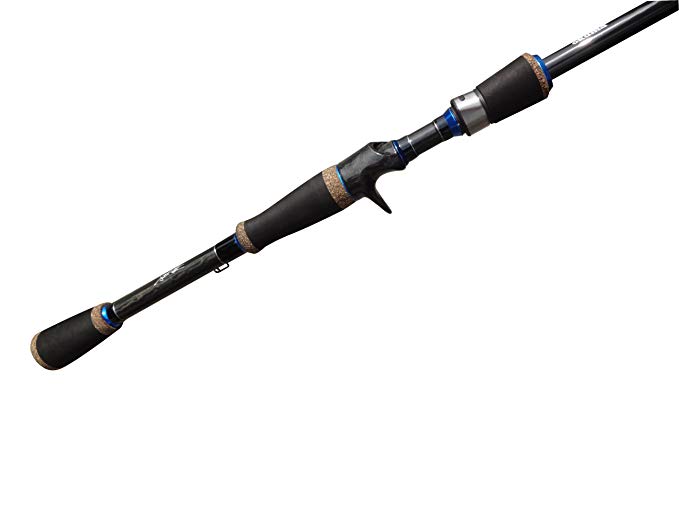
- Stand Out Features - Why We Love It
- Bass flipping rod but also suited for trout, catfish, salmon, and more
- Great for salt and freshwater fishing
- Ideal for use with braided line
- Built for extreme conditions
- More power for tournament style fishing
Weight: 5 ounces
Length: 7 feet 11 inches
Material: Carbon, aluminum oxide
Action: Fast
Power: Heavy
Pieces: 1
How To Choose A Flipping And Pitching Rod – Buying Guide
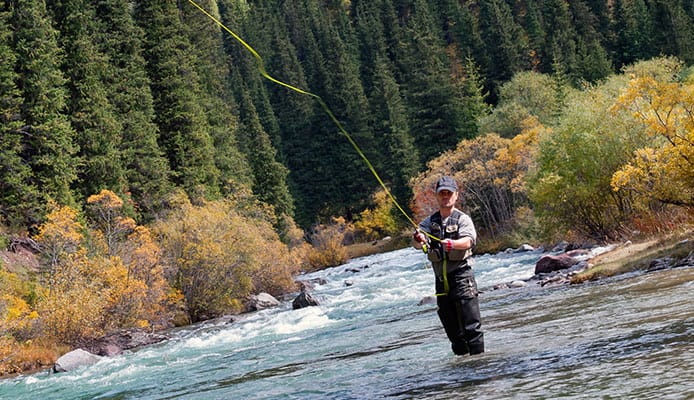
Length
The best flipping rod will be shorter in length because you need to be in closer proximity to your target in order to properly execute the flipping technique. While you don’t want to be too close, the best pitching rod will be the perfect length that the fish can’t see you, but you aren’t struggling to maneuver your setup either.
Most rods for flipping and pitching will be between seven and eight feet in length. This length is a good distance for you to be out of view of the fish, but still be close enough that you can properly flip and pitch. However, the length of your rod may also depend on your level of skill.
Beginner flipping rods for bass and other species would be better off being a little shorter. This is because fishermen who are new to flipping and pitching will be able to better learn the technique when they have less rod length to handle. An experienced fishermen may prefer a longer flipping stick to ensure that the fish cannot see them.
You might also be interested in:
Tip
It is important that you find the proper tip for your flipping stick because this will ensure you have better accuracy and casting distance. The best flipping rod setup would use a tip that is more flexible. If your tip is too stiff, your rod for flipping will be less accurate as you cast. With more flexibility, you can easily maneuver your bass flipping rod into the correct position.
Weight
The weight of the rod is also an important consideration because you want it to be heavy enough that it can handle fighting strong fish, but still light enough that you aren’t struggling to carry your gear to your fishing location. A top rated pitching rod would perfectly balance weight with strength and provide you with a design that is made of graphite.
The lightest flipping stick will feature graphite, which is a strong material that helps you save on weight. Most fish that you’ll hunt for with the flipping and pitching technique will be 8 pounds or more, so you should look for a flipping stick that has the weight to hold more than 10 pounds.
Durability
Flipping rods for bass and other large species need to be durable because the fish will put up a fight. As the fish pulls, flips, twists, and turns, the pressure of the tugging will put more strain on your flipping and pitching rod as you attempt to reel in your catch. The best pitching rod will ensure that it does not snap or break during this fight.
But durability also means that your rod for flipping and pitching will be useful for multiple trips and adventures. Even a flipping rod under 100 dollars should have the durability to last you throughout the years without breaking or showing signs of damage.
Versatility
A bass flipping rod may actually be more versatile than you think, which means that you can use it for different fishing conditions and species. If you aren’t going to always be using the flipping or pitching technique, it may be better to look for a versatile rod that can be used with other techniques too. A versatile rod for flipping will reduce the amount of gar you need and eliminate the hassle of having to carry multiple fishing rods or setups.
Backbone
The backbone is also the spine of your flipping stick, which can affect the balance, performance, and durability of your rod for flipping. The best flipping rod will have a strong backbone that is also flexible. The flexibility ensures that your rod for flipping and pitching won’t break as it bends with the pull of a fish, while the strength ensures that your rod won’t break into two pieces.
A better designed backbone will also ensure that you can make better casts and easily maneuver your bass flipping rod into position. If you are concerned about the strength or design of a model, flipping rod reviews are a great resource that you can you to determine the. quality of a design.
Handle
The handle is another important feature because it should be comfortable but give you the strength and security to successfully reel in fish. The best pitching rod will use a sturdy material in the handle, but it may be synthetic or natural. EVA foam is the most popular synthetic material used in a top rated pitching rod handle that gives you exceptional grip. The rubbery feel increases your traction and ensures that you’ll never drop your rod or watch it slip from your hands.
For fishermen who like a more classic appearance or appreciate a more organic feel, cork is the most popular natural material used in the handles of flipping rods for bass. Cork is a strong material that is also lightweight, so that you get a perfectly balanced handle to manage your rod and fish.
Action
The action of a flipping and pitching rod determines how much the rod bends as you apply pressure on the tip. A fast action rod will only be flexible close to the tip of the lightest flipping stick and returns to a straight position faster. With smaller fish, the fast action is best because you don’t need more flex to reel them into shore.
A medium action rod for flipping will bend in the upper half of the design and is better for larger fish. The extra bend will ensure that your rod does not snap in half under the pressure and will assist you in successfully brining in your catch. A top rated flipping rod should be a medium action, but you may find some designs that are suited for smaller species that is fast action.
FAQs
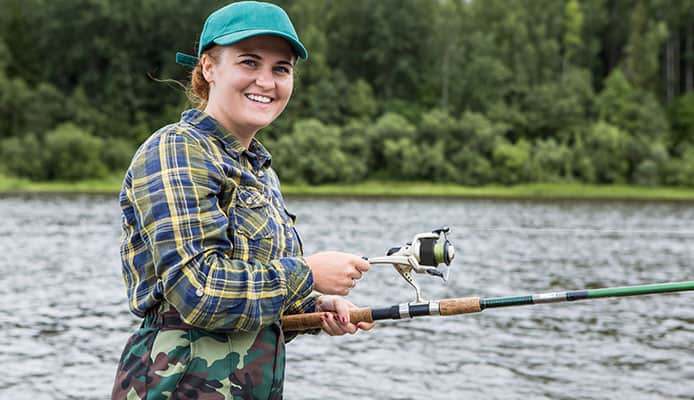
Q: What Line Do You Use For Flipping and Pitching?
Any line because it will depend on the species of fish that you are hunting. A rod for flipping and pitching should be versatile enough that you can use any fishing line that you wish with your setup. Braided lines are better for larger fish because they are less likely to break, but you may need the sensitivity of a monofilament line for smaller fish. Flipping rod reviews can also be a way to find the best fishing line for your setup and give you advice on which line to choose.
Q: What Is Flipping And Pitching?
Flipping and pitching is a fishing technique that is predominantly used in shallow waters and in obstructed locations. The flipping technique has you pull an arm’s length of line off of your reel as you then gently swing your bait into its proper location. Flipping is mostly used in close proximity and can help you fish in waters that have lots of plants or debris.
Pitching is another method that uses short casts for precise placement. Instead of casting further, you can get better accuracy and aim with a shorter cast. The short casts of the pitching technique allow you to target specific fish in the water. The best pitching rod will be shorter in length to allows you better control over short casts.
Q: How Do You Fish A Flipping Jig?
Flipping jigs have four components that you’ll have to learn how to use. The four main components are lead-molded head, weed guard, hook, and skirt. All of the components combined will help you cast and set your lure to the desired depth. Rods for flipping and pitching are also more popular because they can be used in plant filled water. But you also need the right hook. With the correct hook, you’ll be more successful with making casts and reeling in fish.
Q: What Is a Flipping Switch On A Baitcaster?
If you are learning how to cast a baitcaster reel, you may notice that your setup has a flipping switch that allows you to use a different method to engage the reel handle. This method has you hold the thumb bar down and flip it. Once you release the thumb bar, the reel will engage without requiring that you turn the handle. This method is faster and allows you to reel in fish faster.
Globo Surf Overview
With all the different fishing techniques, it is important tlihat you use the proper gear for each technique. A flipping and pitching rod can help you perfect your fishing when you are in casting in concentrated or small areas. The best flipping rod will be durable, reliable, and functional so that you have a great time fishing and can perfect this popular technique.


